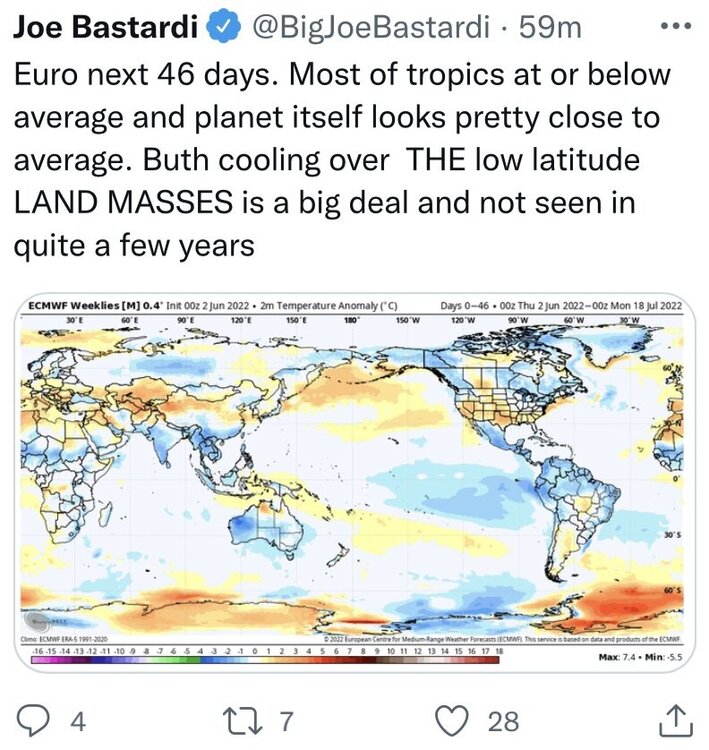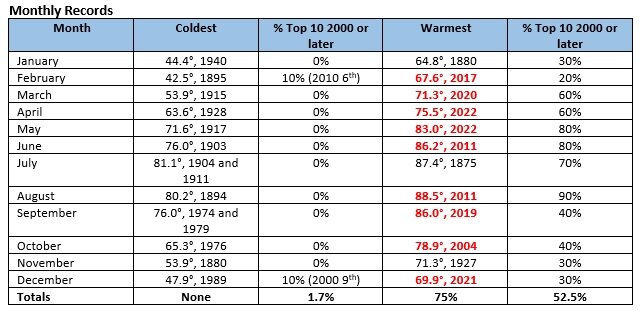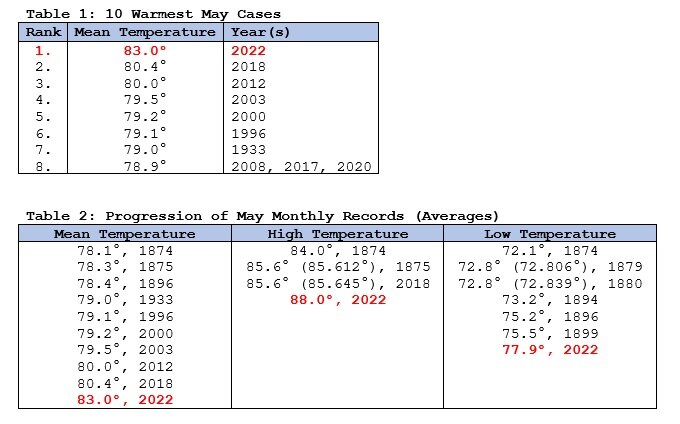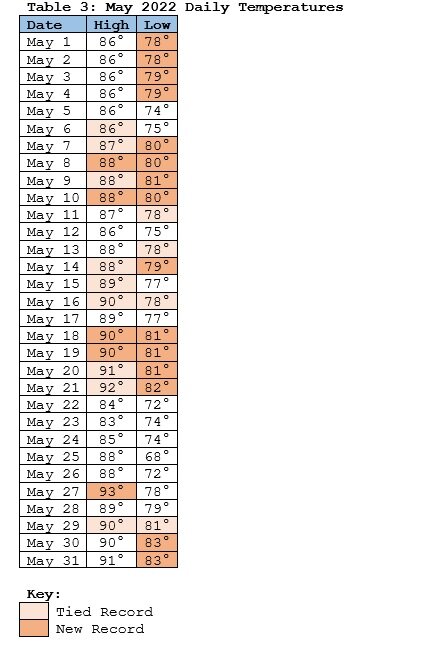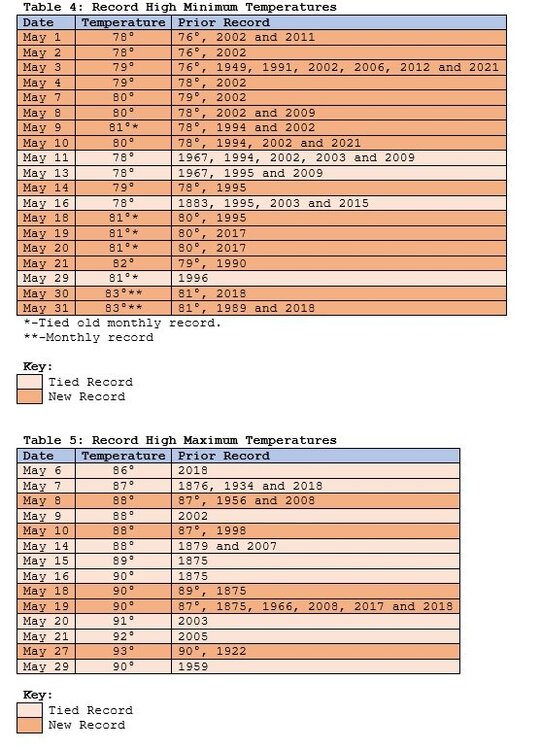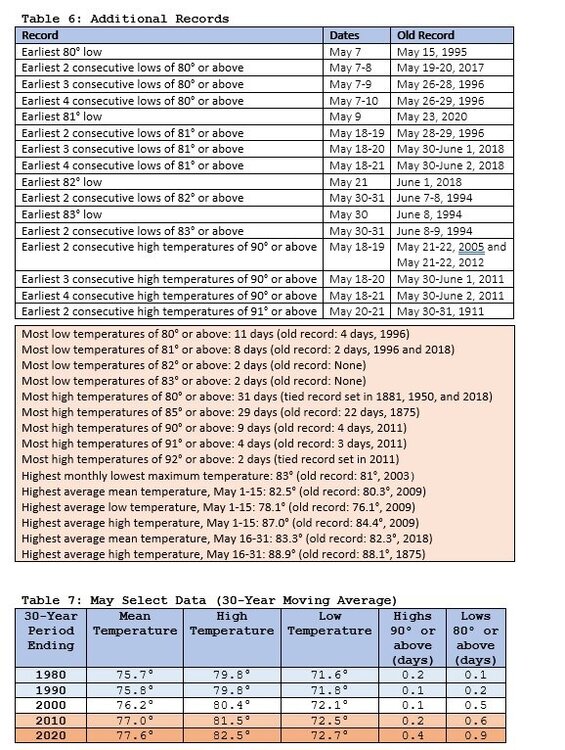-
Posts
22,985 -
Joined
Content Type
Profiles
Blogs
Forums
American Weather
Media Demo
Store
Gallery
Everything posted by donsutherland1
-
The weather will become somewhat more unsettled over the next several days. Temperatures should remain fairly close to normal. No excessive heat appears likely through the weekend. Excessive heat is likely to develop in the desert Southwest late in the week. Phoenix will likely see its first 110° or above temperatures of the year. During 1961-90, Phoenix averaged 15.9 110°+ days per year. For the 1991-20 base period, that number has increased to 20.8 days. During the closing week of May, the MJO moved through Phase 6 with an amplitude as high as 1.909. The only case with an MJO passage through Phase 6 with an amplitude of 1.500 or above during that timeframe was 1998. In 1998, the second half of June was noticeably warmer than the first half. The MJO's ongoing progression and the state of Atlantic blocking could impact the outcome for the second half of June. The ECMWF seasonal forecast indicates that the summer will be warmer than normal throughout the region and across much of North America. Based on how the pattern has been evolving during the spring transition to summer, it is more likely than not that the warmest anomalies of the summer will likely occur in July and August with June being the coolest of the three months in the Northeast. The ENSO Region 1+2 anomaly was -0.6°C and the Region 3.4 anomaly was -0.9°C for the week centered around June 1. For the past six weeks, the ENSO Region 1+2 anomaly has averaged -1.33°C and the ENSO Region 3.4 anomaly has averaged -1.07°C. La Niña conditions will likely persist through the summer. The SOI was +31.35 today. That surpassed the daily record of 26.50, which was set in 2008. It was also the 10th highest daily figure on record for June. The preliminary Arctic Oscillation (AO) was -1.776 today. On June 4 the MJO was in Phase 8 at an amplitude of 2.181 (RMM). The June 3-adjusted amplitude was 2.011 (RMM).
-
Morning thoughts… It will be sunny and warm. High temperatures will reach the lower and middle 80s in most of the region. Likely high temperatures around the region include: New York City (Central Park): 81° Newark: 84° Philadelphia: 84° Clouds will increase tomorrow. There could be some late day or evening showers. Normals: New York City: 30-Year: 76.9°; 15-Year: 77.0° Newark: 30-Year: 78.8°; 15-Year: 79.1° Philadelphia: 30-Year: 80.4°; 15-Year: 80.7°
-
Abundant sunshine and close to seasonable temperatures will again prevail tomorrow. Afterward, the weather will grow somewhat more unsettled. No excessive heat appears likely through at least most of next week. Excessive heat is likely to develop in the desert Southwest late in the week. Phoenix will likely see its first 110° or above temperatures of the year. During 1961-90, Phoenix averaged 15.9 110°+ days per year. For the 1991-20 base period, that number has increased to 20.8 days. During the closing week of May, the MJO moved through Phase 6 with an amplitude as high as 1.909. The only case with an MJO passage through Phase 6 with an amplitude of 1.500 or above during that timeframe was 1998. In 1998, the second half of June was noticeably warmer than the first half. The MJO's ongoing progression and the state of Atlantic blocking could impact the outcome for the second half of June. The ECMWF seasonal forecast indicates that the summer will be warmer than normal throughout the region and across much of North America. Based on how the pattern has been evolving during the spring transition to summer, it is more likely than not that the warmest anomalies of the summer will likely occur in July and August with June being the coolest of the three months in the Northeast. The ENSO Region 1+2 anomaly was -1.1°C and the Region 3.4 anomaly was -1.0°C for the week centered around May 25. For the past six weeks, the ENSO Region 1+2 anomaly has averaged -1.55°C and the ENSO Region 3.4 anomaly has averaged -1.08°C. La Niña conditions will likely persist through the summer. The SOI was +23.62 today. The preliminary Arctic Oscillation (AO) was -2.094 today. On June 3 the MJO was in Phase 8 at an amplitude of 2.010 (RMM). The June 2-adjusted amplitude was 1.994 (RMM).
-
Yes, July 1955 held the record until July 1999.
-
Morning thoughts… It will be sunny and warm. High temperatures will reach the upper 70s and lower 80s in most of the region. Likely high temperatures around the region include: New York City (Central Park): 76° Newark: 81° Philadelphia: 82° Fair weather with near seasonable temperatures will continue through tomorrow. Normals: New York City: 30-Year: 76.6°; 15-Year: 76.7° Newark: 30-Year: 78.4°; 15-Year: 78.8° Philadelphia: 30-Year: 80.1°; 15-Year: 80.4°
-
Abundant sunshine and close to seasonable temperatures will prevail through at least early next week. Tomorrow will likely be the coolest day. No excessive heat appears likely through at least most of next week. Excessive heat is likely to develop in the desert Southwest late next week. Phoenix will likely see its first 110° or above temperatures of the year. During the closing week of May, the MJO moved through Phase 6 with an amplitude as high as 1.909. The only case with an MJO passage through Phase 6 with an amplitude of 1.500 or above during that timeframe was 1998. In 1998, the second half of June was noticeably warmer than the first half. The MJO's ongoing progression and the state of Atlantic blocking could impact the outcome for the second half of June. The ECMWF seasonal forecast indicates that the summer will be warmer than normal throughout the region and across much of North America. Based on how the pattern has been evolving during the spring transition to summer, it is more likely than not that the warmest anomalies of the summer will likely occur in July and August with June being the coolest of the three months in the Northeast. The ENSO Region 1+2 anomaly was -1.1°C and the Region 3.4 anomaly was -1.0°C for the week centered around May 25. For the past six weeks, the ENSO Region 1+2 anomaly has averaged -1.55°C and the ENSO Region 3.4 anomaly has averaged -1.08°C. La Niña conditions will likely persist through the summer. The SOI was +12.30 today. The preliminary Arctic Oscillation (AO) was -2.390 today. The old daily record was -1.919, which was set in 1984. On June 2 the MJO was in Phase 7 at an amplitude of 1.992 (RMM). The June 1-adjusted amplitude was 1.915 (RMM).
-
From Twitter: “Disappearing” the warming. The trick: Use the model’s 1991-2020 baseline without disclosing that baseline is much warmer than those used by the major climate records (GISS, NCDC, Berkeley, HadCrut, etc.). What appears as normal is actually well above normal in the climate record.
-
No. They are all over the place. Most 95-degree readings: Bridgeport: 8, 1949 Islip: 7, 1999 New York City-JFK: 10, 2010 New York City-LGA: 14, 1955 New York City-NYC: 16, 1955 Newark: 25, 1993
-
At Central Park, July 1999 (81.4) is the warmest month. 2010 was 81.3, but the actual figure was likely higher due to the trees shading the instruments.
-
Morning thoughts… It will be sunny and warm. High temperatures will reach the upper 70s and lower 80s in most of the region. Likely high temperatures around the region include: New York City (Central Park): 81° Newark: 85° Philadelphia: 86° Fair weather with near seasonable temperatures will continue into early next week. Normals: New York City: 30-Year: 76.3°; 15-Year: 76.5° Newark: 30-Year: 78.1°; 15-Year: 78.5° Philadelphia: 30-Year: 79.7°; 15-Year: 80.2°
-
Yes. It had 16 such days. 1988 is second with 14. That’s at Central Park.
-

Anchorage's Record-Breaking Summer of 2019
donsutherland1 replied to donsutherland1's topic in Climate Change
Less than 2 years after Anchorage’s historic summer, Anchorage has recorded its earliest streak of 8 consecutive 70-degree days (May 27-June 3). The prior record was set during June 26-July 3, 2019. Today’s preliminary 78-degree high was the earliest such temperature on record. The previous mark was set on June 10, 1995. Meanwhile, Juneau saw its earliest 3 consecutive 80-degree days (June 1-3). The old record was set during June 5-7, 1980. -
The weekend into early next week will feature abundant sunshine and close to seasonable temperatures. Sunday will likely be the coolest day. No excessive heat appears likely through at least most of next week. During the closing week of May, the MJO moved through Phase 6 with an amplitude as high as 1.909. The only case with an MJO passage through Phase 6 with an amplitude of 1.500 or above during that timeframe was 1998. In 1998, the second half of June was noticeably warmer than the first half. The MJO's ongoing progression and the state of Atlantic blocking could impact the outcome for the second half of June. The ECMWF seasonal forecast indicates that the summer will be warmer than normal throughout the region and across much of North America. Based on how the pattern has been evolving during the spring transition to summer, it is more likely than not that the warmest anomalies of the summer will likely occur in July and August with June being the coolest of the three months in the Northeast. The ENSO Region 1+2 anomaly was -1.1°C and the Region 3.4 anomaly was -1.0°C for the week centered around May 25. For the past six weeks, the ENSO Region 1+2 anomaly has averaged -1.55°C and the ENSO Region 3.4 anomaly has averaged -1.08°C. La Niña conditions will likely persist through the summer. The SOI was +1.62 today. The preliminary Arctic Oscillation (AO) was -2.756 today. The previous daily record low was -1.770, which was set in 1985. On June 1 the MJO was in Phase 7 at an amplitude of 1.913 (RMM). The May 31-adjusted amplitude was 1.912 (RMM).
-

Galveston’s Record Warm Late Spring and Early Summer
donsutherland1 replied to donsutherland1's topic in Climate Change
With a high temperature of 90° as of 4 pm CDT, Galveston has now had 6 consecutive days with high temperatures of 90° or above. The 5/29-6/3 period is the earliest such stretch of 6 consecutive days. The old record was 5/31-6/5/1875.- 29 replies
-
1955 also saw the kind of strong blocking currently in place during the first 10 days of June.
-
Morning thoughts… Clouds, showers, and mist will give way to increasing sunshine. High temperatures will reach the upper 70s and lower 80s in most of the region. Likely high temperatures around the region include: New York City (Central Park): 78° Newark: 81° Philadelphia: 83° Fair weather with near seasonable temperatures will continue into early next week. Normals: New York City: 30-Year: 76.0°; 15-Year: 76.2° Newark: 30-Year: 77.8°; 15-Year: 78.2° Philadelphia: 30-Year: 79.4°; 15-Year: 79.9°
-
A cold front triggered heavy thunderstorms this evening producing highway flooding in parts of the New York City area and Westchester County. A few more showers and thundershowers are possible overnight into tomorrow morning. Afterward, a period of more seasonable temperatures will follow. During the closing week of May, the MJO moved through Phase 6 with an amplitude as high as 1.909. The only case with an MJO passage through Phase 6 with an amplitude of 1.500 or above during that timeframe was 1998. In 1998, the second half of June was noticeably warmer than the first half. The MJO's ongoing progression and the state of Atlantic blocking could impact the outcome for the second half of June. The ECMWF seasonal forecast indicates that the summer will be warmer than normal throughout the region and across much of North America. Based on how the pattern has been evolving during the spring transition to summer, it is more likely than not that the warmest anomalies of the summer will likely occur in July and August with June being the coolest of the three months in the Northeast. The ENSO Region 1+2 anomaly was -1.1°C and the Region 3.4 anomaly was -1.0°C for the week centered around May 25. For the past six weeks, the ENSO Region 1+2 anomaly has averaged -1.55°C and the ENSO Region 3.4 anomaly has averaged -1.08°C. La Niña conditions will likely persist through the summer. The SOI was -13.57 today. That was the second consecutive day on which the SOI was below 0. The last time that happened was during February 13-16 when the SOI was negative for four consecutive days. The preliminary Arctic Oscillation (AO) was -2.646 today. The old daily record was -1.652 from 1993. On May 31 the MJO was in Phase 7 at an amplitude of 1.910 (RMM). The May 30-adjusted amplitude was 2.033 (RMM).
-

Galveston’s Record Warm Late Spring and Early Summer
donsutherland1 replied to donsutherland1's topic in Climate Change
With a high temperature of 92° as of 2 pm CDT, Galveston has now had 5 consecutive days with high temperatures of 90° or above. The 5/29-6/2 period is the earliest such stretch of 5 consecutive days. The old record was 5/31-6/4/1875.- 29 replies
-
Morning thoughts… Today will be mostly cloudy with afternoon or evening thunderstorms, some of which could be strong or severe. High temperatures will reach the upper 70s and lower 80s in most of the region. Likely high temperatures around the region include: New York City (Central Park): 77° Newark: 80° Philadelphia: 85° Fair weather with near seasonable temperatures will develop tomorrow and continue into early next week. Normals: New York City: 30-Year: 75.7°; 15-Year: 76.0° Newark: 30-Year: 77.4°; 15-Year: 77.9° Philadelphia: 30-Year: 79.1°; 15-Year: 79.6°
-
In the wake of the passage of a strong backdoor cold front, temperatures in the northern Middle Atlantic region were around 20°-30° cooler than yesterday's highs. The heat continued from Philadelphia and southward. Following overnight showers and thundershowers, tomorrow will be warmer again with readings returning to the upper 70s and at least lower 80s in much of the northern Middle Atlantic region. However, a cold front will trigger thunderstorms, some of which can be strong. Afterward, a period of more seasonable temperatures will follow. During the closing week of May, the MJO moved through Phase 6 with an amplitude as high as 1.909. The only case with an MJO passage through Phase 6 with an amplitude of 1.500 or above during that timeframe was 1998. In 1998, the second half of June was noticeably warmer than the first half. The MJO's ongoing progression and the state of Atlantic blocking could impact the outcome for the second half of June. The ECMWF seasonal forecast indicates that the summer will be warmer than normal throughout the region and across much of North America. Based on how the pattern has been evolving during the spring transition to summer, it is more likely than not that the warmest anomalies of the summer will likely occur in July and August with June being the coolest of the three months in the Northeast. The ENSO Region 1+2 anomaly was -1.1°C and the Region 3.4 anomaly was -1.0°C for the week centered around May 25. For the past six weeks, the ENSO Region 1+2 anomaly has averaged -1.55°C and the ENSO Region 3.4 anomaly has averaged -1.08°C. La Niña conditions will likely persist through the summer. The SOI was -4.64 today. The preliminary Arctic Oscillation (AO) was -2.641 today. That breaks the previous record low of -1.956 from 1975. On May 30 the MJO was in Phase 7 at an amplitude of 2.035 (RMM). The May 29-adjusted amplitude was 1.909 (RMM).
-

Galveston’s Record Warm Late Spring and Early Summer
donsutherland1 replied to donsutherland1's topic in Climate Change
The impact of climate change can be seen from Galveston's monthly temperature records. None of Galveston's cold monthly records occurred during or after 2000. In contrast, 9 of the 12 warm monthly records occurred since 2000; 8 of 12 occurred since 2010; and, 4 of 12 have occurred since 2020. In terms of annual records, the coldest year was 1979 with a mean temperature of 67.7°. The coldest year since 2000 was 2010 with a mean temperature of 70.2°. 2010 ranked as the 72nd coldest year overall. The warmest year was 2017 with a mean temperature of 74.4°. All of the 10 warmest years have occurred since 2000. For perspective, the 2000s currently account for 15.1% of Galveston’s climate record (May 1874 through May 2022).- 29 replies
-

Galveston’s Record Warm Late Spring and Early Summer
donsutherland1 replied to donsutherland1's topic in Climate Change
SSTs near Galveston were running 3-4 degrees above normal.- 29 replies
-
Morning thoughts… Today will be variably cloudy and noticeably cooler in the northern Mid-Atlantic and southern New England areas. Farther south including Washington, DC to Philadelphia, today will be another hot day. High temperatures will range lower 70s in the northern Mid-Atlantic region to lower 90s from Washington, DC to Philadelphia. Afternoon or evening thundershowers are possible. Likely high temperatures around the region include: New York City (Central Park): 73° Newark: 75° Philadelphia: 90° Tomorrow will be somewhat warmer. A cold front will bring thunderstorms, some of which could be strong. Normals: New York City: 30-Year: 75.4°; 15-Year: 75.8° Newark: 30-Year: 77.1°; 15-Year: 77.7° Philadelphia: 30-Year: 78.8°; 15-Year: 79.3°
-
May came to a close with a blaze of heat. Near record and record temperatures were registered across the region. Highs included: Allentown: 92° Atlantic City: 95° Baltimore: 96° Bridgeport: 94° (old record: 91°, 1987 and 2013) Harrisburg: 92° Islip: 93° (old record: 92°, 1987) New Haven: 95° (old record: 87°, 2013) ***New May Record*** New York City-JFK: 94° (old record: 92°, 1988) New York City-LGA: 93° New York City-NYC: 93° Newark: 98° (old record: 96°, 1987) Philadelphia: 96° Poughkeepsie: 93° Scranton: 92° (old record: 91°, 1939 and 2011) Westhampton: 93° (old record: 86°, 2013) White Plains: 92° (old record: 90°, 1987 and 2013) Washington, DC: 96° New York City will finish May with a mean temperature of 64.0°, which is 0.8° above normal. The heat was coming to an abrupt end as a backdoor cold front sliced southwestward. In the wake of the frontal passage, tomorrow will be noticeably cooler. However, much above normal temperatures will likely persist from Philadelphia southward in the Middle Atlantic region through the middle of the week. Galveston is concluding May with monthly mean temperature of 83.0°. That easily breaks the record of 80.4°, which was set in 2018. During May, Galveston recorded 9 90° high temperatures (old record: 4 days, 2011) and 11 80° low temperatures (old record: 4 days, 1996). The first week of June will likely see near seasonable temperatures. Overall, the month will likely wind up warmer than normal. The ECMWF seasonal forecast indicates that the summer will be warmer than normal throughout the region and across much of North America. The ENSO Region 1+2 anomaly was -1.1°C and the Region 3.4 anomaly was -1.0°C for the week centered around May 25. For the past six weeks, the ENSO Region 1+2 anomaly has averaged -1.55°C and the ENSO Region 3.4 anomaly has averaged -1.08°C. La Niña conditions will likely persist through the summer. The SOI was +16.10 today. The preliminary Arctic Oscillation (AO) was -2.281 today. That edges the daily record low of -2.216 from 2016. On May 29 the MJO was in Phase 6 at an amplitude of 1.909 (RMM). The May 28-adjusted amplitude was 1.384 (RMM).
-

Galveston’s Record Warm Late Spring and Early Summer
donsutherland1 posted a topic in Climate Change
Galveston experienced its warmest December on record last year with a mean temperature of 69.9°, which crushed the old mark of 66.4° that had stood since 1889. The December temperature average was warm enough to qualify as that city's 7th warmest November on record. Since then, one or more record-breaking or record-tying high temperatures were set in each month. April 2022 was the warmest April on record with a mean temperature of 75.5° (old record: 75.0°, 1967 and 2017). Just five months after the historic December warmth, May experienced historic warmth that demolished the monthly record that was set in 2018.The combination of dry conditions, development of a persistent heat dome, and much warmer than normal water temperatures amplified by the impact of climate change produced the record outcome. Summary information on the impacts of climate change in the Houston and Galveston areas can be found here:https://www.globalchange.gov/sites/globalchange/files/CCPR_HOU_brochure-final.pdfFor background information, the mean temperature rose 2.0° at Galveston from the 1961-1990 period to the 1991-2020 period. The number of 90° days rose particularly sharply. Annual temperature: 1961-90: 69.7°; 1991-20: 71.7°Number of days with highs of 80° or above: 1961-90: 151.0 days; 1991-20: 175.7 daysNumber of days with highs of 85° or above: 1961-90: 92.3 days; 1991-20: 126.0 daysNumber of days with highs of 90° or above: 1961-90: 13.5 days; 1991-20: 58.2 daysNumber of days with lows of 80° or above: 1961-90: 52.1 days; 1991-20: 62.3 daysThe last year with fewer than 100 85° days was 1997 when there were 94 such days. The last year with fewer than 20 90° days was 1992 when there were just 7 such days.80° warmth has now been occurring both earlier and later in the season as the "hot" season lengthens.Number of days with highs of 80° or above in March-April: 1961-90: 1.1 days; 1991-20: 4.3 daysNumber of days with highs of 80° or above in November-December: 1961-90: 0.5 days; 1991-20: 1.8 daysThe synoptic pattern, regional drought, and warm sea surface temperatures occurred against the backdrop of a warming climate that was resulting in a dramatic increase in hot days. As a result, May 2022 essentially rewrote the record book for warmth in May. Charts follow: Updates: Warmest first week of June Warmest June 1-15 Warmest June on Record Stations with 3 consecutive record warm months with long periods of record (through June 2022) Summers in Galveston Stations with 3 consecutive record warm months with long periods of records (through July 2022) Hottest July and Month on Record- 29 replies
-
- 3
-




